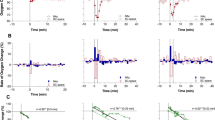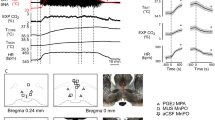Abstract
IN the cat, electrical stimulation1,2 or selective lesions of the brain3 can evoke an affected display of anger, called sham rage3. This emotional display is often coupled with directed prey killing or attack behaviour2. Associated with this is a widespread activation of the sympathetic nervous system and a release of the catecholamines, noradrenaline and adrenaline, from the adrenal gland4,5. It was recently demonstrated that, when prolonged, increased neural release of adrenal catecholamines is associated with increased activity of tyrosine hydroxylase6,7, the enzyme of the rate-limiting step in catecholamine biosynthesis8. The increase in enzyme activity is presumably the result of production of new enzyme6,9. We have sought to determine whether the induction of attack behaviour in the cat by electrical stimulation of the hypothalamus, if sustained over several days, can lead to similar changes in adrenal tyrosine hydroxylase and also the adrenal enzyme phenylethenol amine-N-methyl transferase (PNMT) which converts norepinephrine to epinephrine.
This is a preview of subscription content, access via your institution
Access options
Subscribe to this journal
Receive 51 print issues and online access
$199.00 per year
only $3.90 per issue
Buy this article
- Purchase on Springer Link
- Instant access to full article PDF
Prices may be subject to local taxes which are calculated during checkout
Similar content being viewed by others
References
Hess, W. R., The Functional Organization of the Diencephalon (Grune and Stratton, New York, 1957).
Wasman, M., and Flynn, J. P., Arch. Neurol., 6, 220 (1962).
Bard, P., Amer. J. Physiol., 84, 490 (1928).
Reis, D. J., and Gunne, L. M., Science, 149, 450 (1965).
Reis, D. J., Miura, M., Weinbren, M., and Gunne, L. M., Science, 156, 1768 (1967).
Weiner, N., and Rabadjija, M., J. Pharmacol. Exp. Ther., 164, 103 (1968).
Mueller, R. A., Theonen, H., and Axelrod, J., J. Pharmacol. Exp. Ther., 169, 74 (1969).
Udenfriend, S., Zaltzman-Nirenberg, P., and Nagatsu, T., Biochem. Pharmacol., 14, 837 (1965).
Mueller, R. A., Theonen, H., and Axelrod, J., Mol. Pharmacol., 5, 563 (1969).
Nagatsu, T., Levitt, M., and Udenfriend, S., J. Biol. Chem., 239, 2910 (1964).
Axelrod, J., J. Biol. Chem., 237, 1657 (1962).
Kvetnansky, R., Gewirtz, G. P., Weise, V. K., and Kopin, I. J., Fed. Proc., 29, 277 (1970).
Molinoff, P. B., Brimijoin, S., Weinshilboum, R., and Axelrod, J., Proc. US Nat. Acad. Sci. (in the press).
Cannon, W. B., The Wisdom of the Body, second ed. (Norton, New York, 1939).
Author information
Authors and Affiliations
Rights and permissions
About this article
Cite this article
REIS, D., MOORHEAD, D., RIFKIN, M. et al. Changes in Adrenal Enzymes synthesizing Catecholamines in Attack Behaviour evoked by Hypothalamic Stimulation in the Cat. Nature 229, 562–563 (1971). https://doi.org/10.1038/229562b0
Received:
Issue Date:
DOI: https://doi.org/10.1038/229562b0
Comments
By submitting a comment you agree to abide by our Terms and Community Guidelines. If you find something abusive or that does not comply with our terms or guidelines please flag it as inappropriate.



